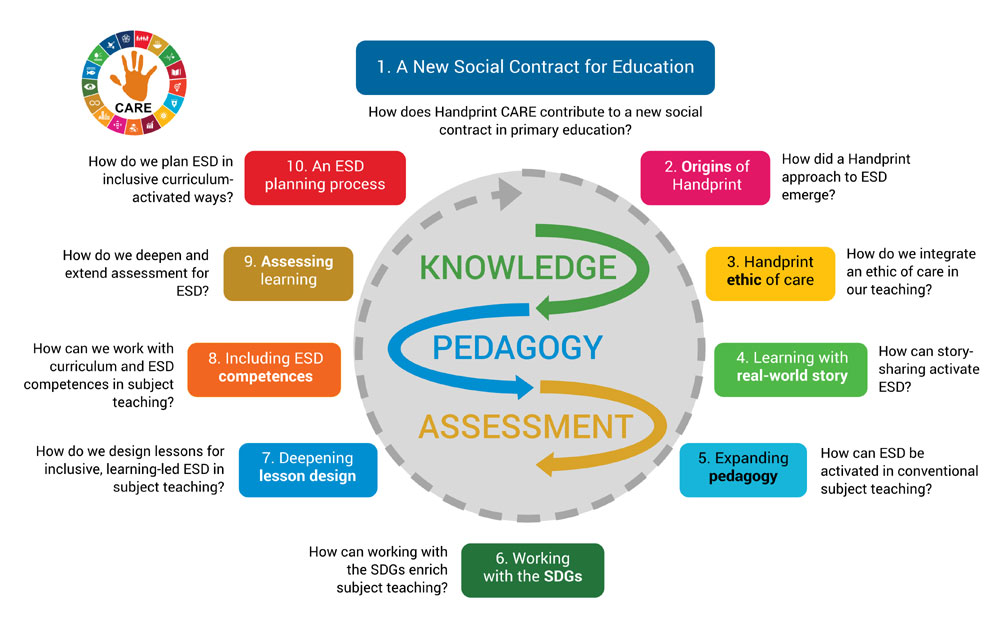As learner-led resources for ESD in school subject teaching
A Handprint CARE approach to subject teaching involves more than simply selecting and undertaking Handprint actions for sustainability. It can unfold as a transformative re-alignment in school subject teaching. Rather than adding even more content into an already overcrowded curriculum, subtle re-alignments involve working more strategically with subject knowledge and ensuring that sustainability practices are foregrounded.

As the realignment is activated in positive learning actions, it becomes possible to re-imagine our futures together and develop a new social contract for education (UNESCO, 2021) (see Chapter 1 – A New Social Contract for Education).
A Handprint approach is developed as a co-engaged process of action learning and as an expansion of conventional teaching practices to strengthen ESD. This was inspired by the spontaneous ethics-led and action-orientated responses of young learners working individually and together to make things better in the world around them (see Chapter 2 – Origins of Handprint).
To support learning-led and action-orientated engagement, participating teachers expanded conventional pedagogy to include both knowledge acquisition and participatory action learning. Here collaborative work with teachers uncovered how cultural heritage and local matters of concern can be taken up within school subjects to enhance relevance and learning that relates to the everyday life of the children. Handprint CARE has thus developed as a platform for ethics led learning actions in school subject teaching (see Chapter 3 – A Handprint Ethics of Care in Subject Teaching).
An ethics-led approach became centered on the inclusion of local cultures and action learning in primary education subject teaching settings. Here teachers explore how real-world1 true stories are a useful way to start up story-sharing in subject teaching by students. Story sharing enables students to begin to acquire relevant knowledge in real-life situations as they participate in collaborative action learning for social justice and future sustainability (see Chapter 4 – Learning with Real- World Stories).
1'Real-world' is used alongside 'real-life' to point to how learning engages both the physical realities in the world around us and the life experiences of students. This repositions knowledge acquisition as a real-world (onto-epistemic) activity where learning is culturally situated (life-experience) and thus both concept-dependent and activity-dependent (see Chapter 7 for an expansion of this critical realist perspective).
We all learn how a Handprint CARE approach could support us to teach school subject knowledge in ways that support our students to engage in current matters of concern. It further enables us to evaluate unsustainable cultural practices and to deliberate and explore alternatives. The Handprint CARE materials and methods in the handbook also support a practical expansion of conventional Teach-Task-Assess approaches (see Chapter 5 – Expanding Subject Pedagogy for ESD).
The materials in this Handbook are also intended to provide adaptable starting points for activating positive learning actions in work with the SDGs (see Chapter 6 – Working with the SDGs) so as to develop ESD competences (see Chapter 8 – Including ESD Competences)
Conventional subject teaching that can be extended to include indepth inquiry to explore how sustainability concerns emerged, has been found to invite inclusion, resonanceseeking inquiry and real-world action learning in school subject settings (see Chapter 7
– Deepening Lesson Design for Transformative Learning).
Finally, the handbook provides a practical overview on continuous and summative assessment schema (see Chapter 9 – Assessing Learning) and concludes with some ideas on co-engaged programme planning (see Chapter 10 – ESD Programme Planning). In Handprint CARE, ESD is approached as a culturally situated and ethics-led social learning process, towards:
Learning to look after others
to best care for each other and
to explore change projects
to improve the surroundings that we all share